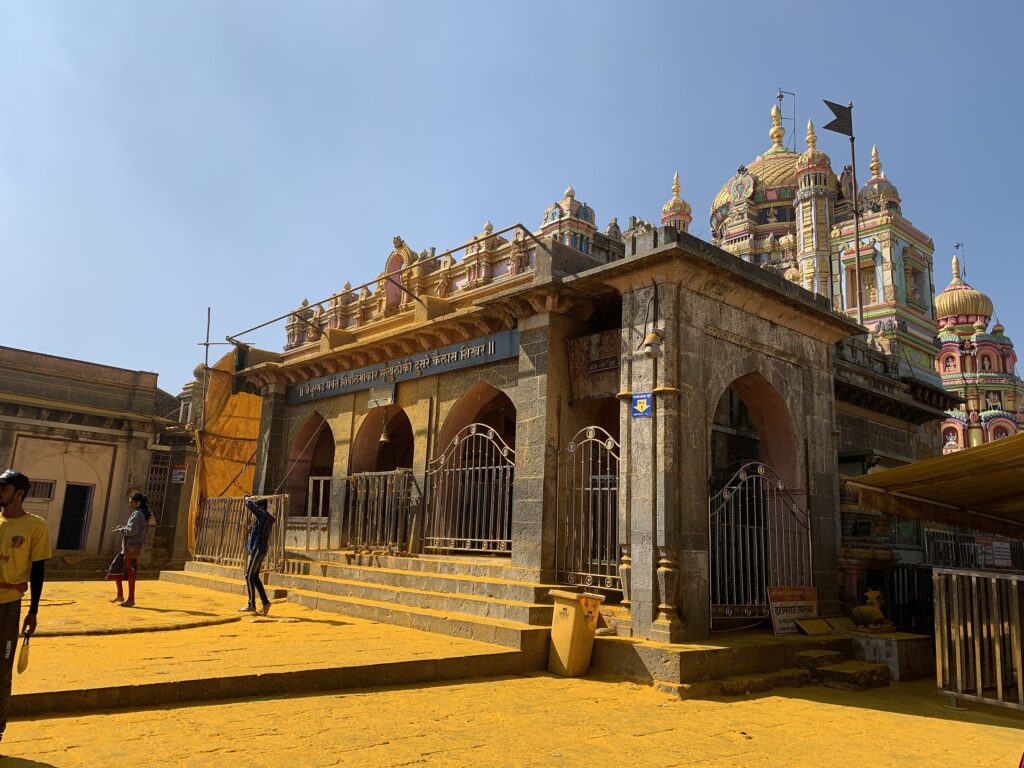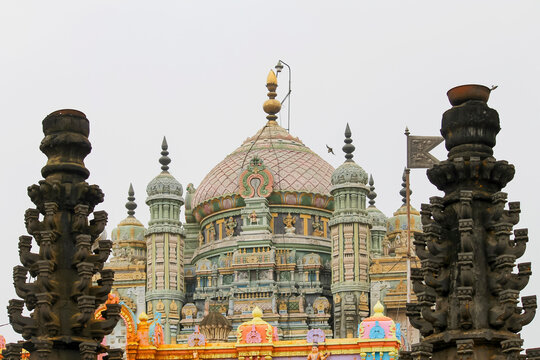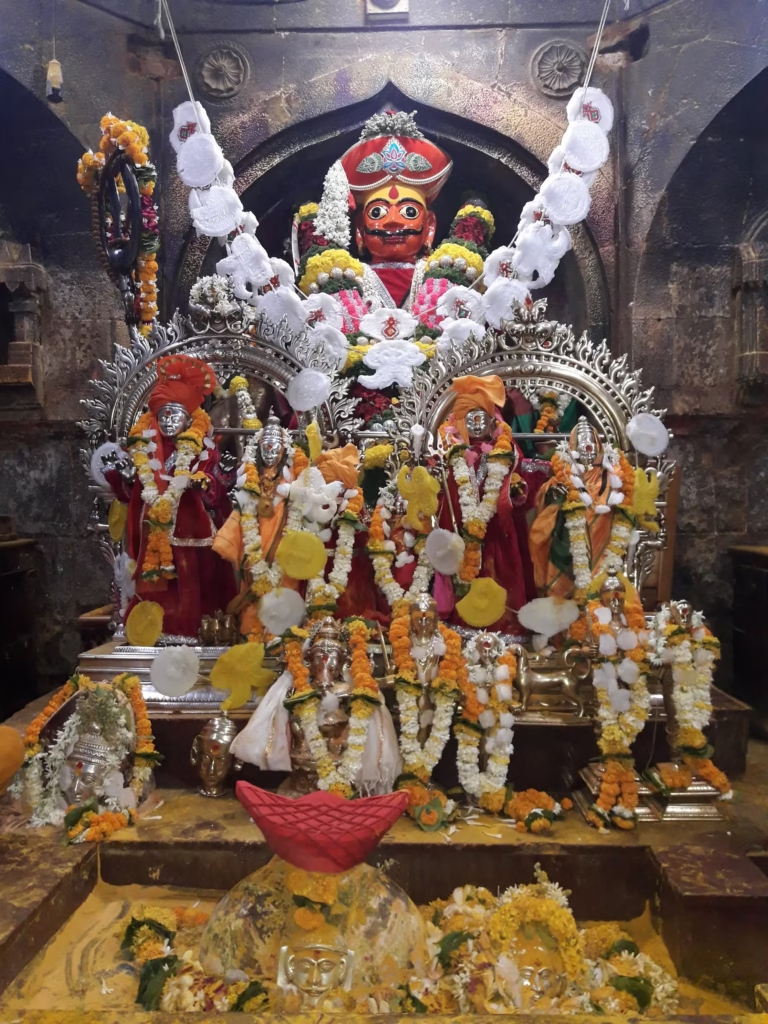Table of Contents
Jejuri: The Sacred Abode of Lord Khandoba
Jejuri, a revered town in Maharashtra’s Pune district, is known as the spiritual center of Lord Khandoba, a warrior deity worshipped primarily by the Dhangar, Marathi-speaking, and farming communities. The town’s Khandoba Temple, perched atop a hill, is the most significant pilgrimage site, offering breathtaking views and a deeply spiritual atmosphere.
A key highlight of Jejuri is the Bhandara Festival, where devotees shower golden turmeric powder (Bhandara) as an offering to Khandoba, creating a mesmerizing spectacle. The temple complex, with its intricate carvings, towering Deepmalas (lamp pillars), and historical significance, attracts both pilgrims and history enthusiasts.
Jejuri is also linked to warrior traditions, as Khandoba is revered as a protector of the land. Rituals like sword fights, folk dances, and devotional singing (Gondhal) are integral to local culture. The town’s vibrant energy, traditional customs, and warm hospitality make it a must-visit for anyone seeking spiritual solace and a glimpse into Maharashtra’s rich heritage. Jejuri stands as a testament to faith, history, and devotion, making it one of Maharashtra’s most cherished religious destinations.

Ancient Roots and Mythological Significance
The origins of Jejuri date back to ancient times, with its history interwoven with mythology and religious traditions. Lord Khandoba, also known as Malhari Martand, is considered an incarnation of Lord Shiva. As per legend, he appeared to defeat the demon brothers Mani and Malla, who were terrorizing the region. After a fierce battle, Khandoba vanquished the demons, became the sacred site where devotees celebrate his victory.
The temple of Khandoba at Jejuri is one of the most significant pilgrimage sites in Maharashtra. According to folklore, the deity was deeply revered by warriors, farmers, and the pastoral communities, who sought his blessings for protection and prosperity. His worship continues to be an integral part of Maharashtra’s religious and social fabric.
The Jejuri Khandoba Temple
The most iconic structure in Jejuri is the Khandoba temple, located atop a hill called Jejuri Gad. The temple is an architectural marvel, blending Hemadpanthi and medieval Maratha styles. Visitors must ascend a flight of nearly 200 steps to reach the temple, a journey symbolic of devotion and perseverance.
At the heart of the temple lies the sanctum, where the deity is enshrined in a warrior form, wielding a sword. The temple’s premises are adorned with deepmalas (lamp towers), intricately carved pillars, and mandapas that reflect the grandeur of Maratha-era temple architecture. The main shrine is surrounded by smaller shrines dedicated to Banai and Mhalsa, the consorts of Khandoba.

The Turmeric Festival: Bhandara Utsav
Jejuri is often called ‘Sonyachi Jejuri’ (Golden Jejuri) due to the famous Bhandara Utsav, a festival where devotees throw turmeric powder in the air, creating a mesmerizing golden spectacle. This grand celebration takes place on Somvati Amavasya and during other festive occasions such as Champa Shashti. The festival symbolizes the prosperity, valor, and devotion associated with Khandoba.
During the celebrations, the temple complex is enveloped in clouds of turmeric, as thousands of devotees chant praises and perform traditional rituals. The sight of the temple bathed in a golden hue is breathtaking and leaves an indelible mark on the minds of visitors.
Historical and Cultural Importance
Jejuri’s significance extends beyond religion. Historically, it served as a prominent center of faith during the Maratha rule. Chhatrapati Shivaji Maharaj, the great Maratha king, is believed to have visited the temple to seek blessings before embarking on military campaigns. The temple’s strategic location atop a hill also made it a vantage point for defense purposes.
In addition to its religious importance, holds cultural value, with its folklore, traditional music, and the oral histories of the Gondhalis (devotional performers) playing a crucial role in preserving the legacy of Khandoba. The vibrant fairs and yatras (pilgrimage festivals) held here attract devotees from across the state and beyond, contributing to the town’s cultural vibrancy.

Modern-Day Jejuri
Today, Jejuri remains a thriving pilgrimage site, attracting thousands of devotees and tourists throughout the year. The temple authorities and local administration have undertaken several measures to preserve its heritage while improving facilities to accommodate the growing number of visitors. Renovation efforts, better crowd management, and improved cleanliness have enhanced the overall pilgrimage experience. Additionally, digital initiatives, such as online darshan and donation services, have made it easier for devotees to stay connected with their faith.
Improved connectivity to Pune and other major cities has made travel more convenient, with well-maintained roads and frequent bus services. The Jejuri railway station also provides easy access for travelers, while nearby lodging options range from budget stays to dharamshalas catering to pilgrims.
Apart from the Khandoba temple, visitors can explore nearby attractions such as the Moreshwar Ganpati Temple in Morgaon, one of the revered Ashtavinayak temples, and historic forts like Purandar Fort, which holds significance in Maratha history.
Local markets in Jejuri offer an array of religious souvenirs, turmeric packets, handcrafted idols, and traditional artifacts, allowing visitors to take home a piece of this sacred town’s legacy. The town’s vibrant culture, coupled with its seamless blend of tradition and modernity, ensures that Jejuri remains a cherished spiritual destination for generations to come.

Festivals and Celebrations
Jejuri comes alive during festivals such as Champashashti and Somvati Amavasya, when thousands of devotees gather to honor Lord Khandoba. The air fills with music, dance, and the fragrance of turmeric powder, creating an uplifting and blissful spiritual experience. These celebrations are not only religious but also a reflection of Maharashtra’s rich cultural heritage.
The Positive Vibe of Jejuri
Visiting Jejuri is more than a pilgrimage—it is a journey of faith, energy, and inner peace. The sacred chants, the golden glow of turmeric, and the breathtaking views from the temple make it a place where one feels truly blessed and inspired.
Legends and Folklore of Khandoba
- Stories of Lord Khandoba’s miracles and divine interventions.
- The connection between Khandoba and his devotees, including the Dhangar and Lingayat communities.
- Folklore surrounding Banai and Mhalsa, Khandoba’s consorts.
Architecture and Design of the Khandoba Temple
- Detailed description of the temple’s layout, carvings, and sculptures.
- Symbolism behind the deepmalas, mandapas, and other architectural features.
- Influence of Maratha and Hemadpanthi styles in temple design.
Rituals and Worship Practices at Jejuri
- Daily temple rituals and their significance.
- Special poojas and aarti performed on auspicious days.
- Offerings made by devotees and the role of priests.
Festivals and Celebrations Beyond Bhandara Utsav
- Champa Shashti: A six-day festival dedicated to Khandoba.
- Somvati Amavasya: Its importance in Khandoba worship.
- Other regional festivals and how they are celebrated in Jejuri.
The Wari Tradition and Pilgrimage to Jejuri
- Comparison of the Warkari movement and Khandoba devotion.
- The spiritual significance of walking to Jejuri as a form of penance.
- Devotee experiences and traditions passed down through generations.
Connection Between Khandoba and Other Deities
- How Khandoba is linked to Lord Shiva and Bhairava traditions.
- The similarities between Khandoba and other warrior deities like Kartikeya and Ayyappa.
- Influence of Khandoba worship across different regions of India.
Impact of Jejuri on Marathi Literature and Arts
- Mentions of Jejuri in Marathi poetry, literature, and historical texts.
- Famous poets and saints who have composed verses on Khandoba.
- Influence of Khandoba worship in Marathi folk music and drama (Tamasha and Gondhal).
Influence of Jejuri on Maratha History and Warfare
- Chhatrapati Shivaji Maharaj’s association with Khandoba.
- How Maratha warriors sought divine blessings before battles.
- The role of Jejuri as a spiritual and strategic stronghold.
Tourism in Jejuri: Beyond the Temple
- Local attractions such as ancient caves, step wells, and scenic viewpoints.
- Natural beauty surrounding Jejuri, including nearby hills and trekking routes.
- Homestays and cultural tourism initiatives by locals.
The Economic and Social Role of Jejuri
- How Jejuri contributes to the local economy through tourism and religious activities.
- The livelihood of artisans, vendors, and priests dependent on temple visitors.
- Community-led initiatives for temple preservation and town development.

Conclusion
Jejuri, with its blend of history, spirituality, and culture, stands as a beacon of faith and devotion. The grandeur of the Khandoba temple, the legendary turmeric festival (Bhandara Utsav), and its deep-rooted connection with Maharashtra’s traditions make it a must-visit destination. The town is not only a religious hub but also a symbol of valor and cultural heritage, deeply intertwined with the history of the Maratha warriors.
Beyond its spiritual essence, Jejuri offers breathtaking views from its hilltop temple, with intricately carved pillars, grand stone architecture, and the towering Deepmalas (lamp towers) that illuminate the temple during special occasions. The chants of devotees, the rhythmic beats of drums, and the golden hues of turmeric create an atmosphere of unmatched energy and devotion.
Whether one seeks divine blessings, an insight into Maratha heritage, or a unique cultural experience, Jejuri offers it all. The town’s rich traditions, festive fervor, and warm hospitality leave a lasting impression on every visitor, making it one of Maharashtra’s most cherished sacred sites and a true gem of spiritual tourism.
Learn More Info
